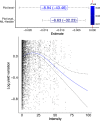The economic impact of schistosomiasis
- PMID: 34895355
- PMCID: PMC8667389
- DOI: 10.1186/s40249-021-00919-z
The economic impact of schistosomiasis
Abstract
Background: The economic impact of schistosomiasis and the underlying tradeoffs between water resources development and public health concerns have yet to be quantified. Schistosomiasis exerts large health, social and financial burdens on infected individuals and households. While irrigation schemes are one of the most important policy responses designed to reduce poverty, particularly in sub-Saharan Africa, they facilitate the propagation of schistosomiasis and other diseases.
Methods: We estimate the economic impact of schistosomiasis in Burkina Faso via its effect on agricultural production. We create an original dataset that combines detailed household and agricultural surveys with high-resolution geo-statistical disease maps. We develop new methods that use the densities of the intermediate host snails of schistosomiasis as instrumental variables together with panel, spatial and machine learning techniques.
Results: We estimate that the elimination of schistosomiasis in Burkina Faso would increase average crop yields by around 7%, rising to 32% for high infection clusters. Keeping schistosomiasis unchecked, in turn, would correspond to a loss of gross domestic product of approximately 0.8%. We identify the disease burden as a shock to the agricultural productivity of farmers. The poorest households engaged in subsistence agriculture bear a far heavier disease burden than their wealthier counterparts, experiencing an average yield loss due to schistosomiasis of between 32 and 45%. We show that the returns to water resources development are substantially reduced once its health effects are taken into account: villages in proximity of large-scale dams suffer an average yield loss of around 20%, and this burden decreases as distance between dams and villages increases.
Conclusions: This study provides a rigorous estimation of how schistosomiasis affects agricultural production and how it is both a driver and a consequence of poverty. It further quantifies the tradeoff between the economics of water infrastructures and their impact on public health. Although we focus on Burkina Faso, our approach can be applied to any country in which schistosomiasis is endemic.
Keywords: Agriculture; Neglected Tropical Diseases; Poverty; Schistosomiasis; Sub-Saharan Africa; Water Resources Development.
© 2021. The Author(s).
Conflict of interest statement
The authors declare that they have no competing interests.
Figures




References
-
- James SL, Abate D, Abate KH, Abay SM, Abbafati C, Abbasi N, et al. Global, regional, and national incidence, prevalence, and years lived with disability for 354 diseases and injuries for 195 countries and territories, 1990–2017: a systematic analysis for the global burden of disease study 2017. Lancet. 2018;392(10159):1789–1858. doi: 10.1016/S0140-6736(18)32279-7. - DOI - PMC - PubMed
MeSH terms
LinkOut - more resources
Full Text Sources

